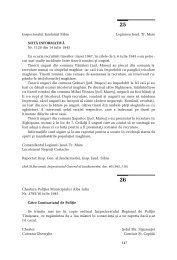Southeast Europe
Southeast Europe
Southeast Europe
You also want an ePaper? Increase the reach of your titles
YUMPU automatically turns print PDFs into web optimized ePapers that Google loves.
Hungarian publications was considerably intensified; the broadcast of territorial radio<br />
stations in Hungarian was stopped by the mid-1980s; geographical and Christian names<br />
in the language of the minorities were prohibited, and villages inhabited by minorities<br />
i.e. Hungarians, started to be demolished. Against this background, Hungarians started<br />
their own samizdat. Restrictions culminated with the closing of the Hungarian<br />
Consulate in Cluj in 1988 after the Hungarian Consul had been officially expelled from<br />
Romania. By the end of the decade, “Romanians of Hungarian language” replaced the<br />
term “co-existing nationalities”, so the dictatorship of the Ceauşescu couple became<br />
coloured with violent nationalism. That was facilitated by their attempt to strengthen the<br />
solidarity of the majority, who were also subjected to pressure and prohibitions (Antal,<br />
1993, Vincze, 1999a: 67-106).<br />
The events of December 1989 in Romania gave hope to the Hungarians of Romania that<br />
there would soon be a change for the better. Ironically, the Hungarian community in<br />
Timişoara, near the Hungarian border, initiated the end of the Ceauşescu regime. The<br />
eviction of the local Hungarian Reformed pastor, László Tőkés instigated actions by the<br />
Hungarians. They began protests and soon were joined by Romanians and others who<br />
also wished to express their discontent with the regime. In support of the<br />
revolutionaries, on December 21, 1989, the Hungarian government decided to abrogate<br />
its 1972 friendship treaty with Romania. Finally, on 25 December 1989, Nicolae and<br />
Elena Ceauşescu were executed and a provisional government calling itself the National<br />
Salvation Front stepped into the breach (Stokes, 1993:163-166). The euphoria of the<br />
victory of the Romanian revolution was manifested in the sphere of Romanian-<br />
Hungarian relations as well. The National Salvation Front included 14 Hungarians,<br />
including personalities such as László Tőkés, Károly Király, and Géza Domokos. The<br />
Hungarian press proclaimed a new era of Romanian-Hungarian relations, symbolised by<br />
the heroic figure of László Tőkés (Rateş, 1992). With the change in government and the<br />
plans for democratic elections, Hungarians in Romania assumed that they would see the<br />
return of educational and other institutions lost under communism. Demands for the<br />
return of the Bolyai High School in Târgu-Mureş, however, led to violent clashes in the<br />
city between Hungarians and Romanians on March 19 and 20, 1990. Whilst inter-ethnic<br />
relations are no longer quite so tense, the topic of education remains at the forefront of<br />
discussions between the Hungarian minority and the Romanian government.<br />
Nevertheless, the riots in Târgu Mureş remain a landmark in the history of the<br />
Romanian-Hungarian relationship after 1989. The Government offered contradictory<br />
explanations and the official parliamentary report, published on January 23, 1991 was<br />
contested by so many that it lost its credibility. Numerous aspects of the riots were<br />
omitted from the analysis (e.g. the presence at the demonstration of Romanian peasants<br />
brought in buses from the nearby villages, etc). Yet, since March 1990, Târgu Mures<br />
has regained its peace (Gallagher 1999:116, 122).<br />
After a period of increased diplomatic tension and isolation, since 1994 bilateral<br />
political relations between the two countries have improved, and Romania and Hungary<br />
have developed a special political and military relationship (Iordachi, 1998:67-76). The<br />
first significant step in the bilateral reconciliation process was the signing of “The<br />
Treaty of Mutual Understanding, Co-operation and Good Neighbourhood,” on<br />
September 16, 1996. The treaty includes the provision that both countries will support<br />
their efforts for NATO and <strong>Europe</strong>an Integration “on a non-discriminatory basis”<br />
(Romania and Minorities, 1997:162); and was accompanied by a “Joint Romanian-<br />
Hungarian Political Statement” and an “Agreement of Reconciliation and Partnership.”<br />
Finally, a significant breakthrough in the Romanian-Hungarian relations occurred in<br />
13









